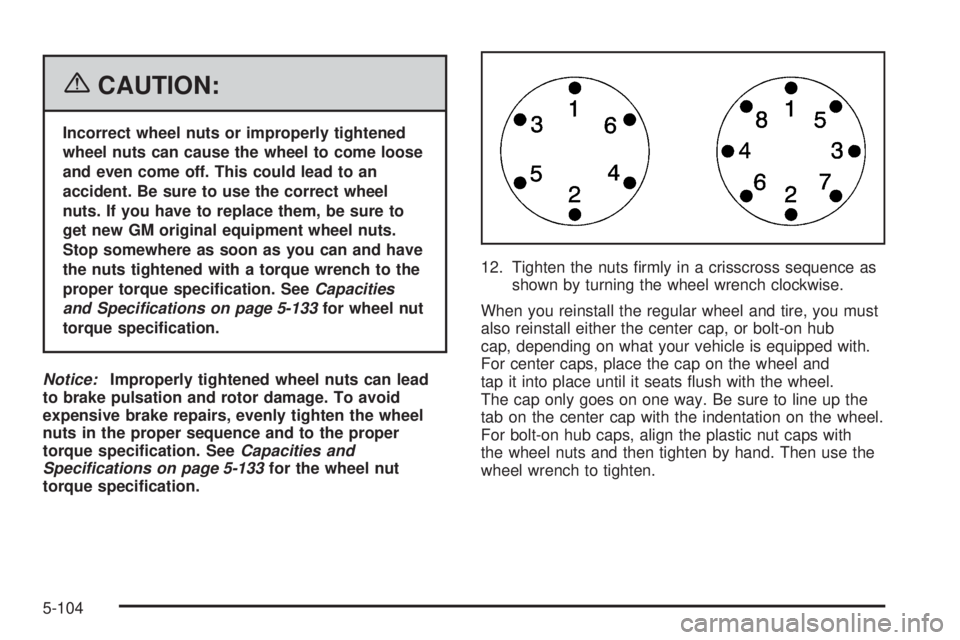Page 481 of 600
3. Determine which of the following taillamp assembly
applies to your vehicle.
A. Stoplamp/Taillamp
B. Turn Signal
C. Back-up LampA. Stoplamp/Taillamp
B. Turn Signal Lamp
C. Back-up Lamp
D. Sidemarker Lamp
4. Press the release tab, if equipped, and turn the
bulb socket counterclockwise to remove it from
the taillamp assembly.
5. Pull the old bulb straight out from the socket.
6. Press a new bulb into the socket and turn the socket
clockwise into the taillamp assembly.
7. Reinstall the taillamp assembly.
5-69
Page 506 of 600

For regular cab models, the equipment you will need is
behind the passenger’s seat. For extended and crew
cab models, the equipment is on the shelf behind
the passenger’s side second row seat.
1. If there is a cover, move the seats forward and turn
the wing nut on the cover counterclockwise to
remove it. For crew cab models, pull up the second
row seat with the loop at the base of the seat
cushion to access the tools.
2. Turn the knob on the jack counterclockwise to lower
the jack head to release the jack from its holder.
3. Remove the wheel blocks and the wheel block
retainer by turning the wing nut counterclockwise.
4. Remove the wing nut used to retain the storage
bag and tools by turning it counterclockwise.You will use the jack handle extensions and the wheel
wrench to remove the underbody-mounted spare tire.
A. Spare Tire (Valve
Stem Pointed Down)
B. Hoist Assembly
C. Hoist Cable
D. Tire Retainer
E. Hoist Shaft
F. Hoist End of
Extension ToolG. Hoist Shaft
Access Hole
H. Wheel Wrench
I. Jack Handle
Extensions
J. Spare Tire Lock
(If Equipped)
5-94
Page 507 of 600
1. Open the spare tire lock cover on the bumper and
use the ignition key to remove the lock, if equipped
with a spare tire lock (J).
2. Assemble the wheel wrench (H) and the two jack
handle extensions (I) as shown.3. Insert the hoist end
(open end) (F) of the
extension through
the hole (G) in the
rear bumper.
Be sure the hoist end of the extension connects to
the hoist shaft (E). The ribbed square end of the
extension is used to lower the spare tire.
4. Turn the wheel wrench (H) counterclockwise to
lower the spare tire to the ground. Continue to
turn the wheel wrench until the spare tire can be
pulled out from under the vehicle.
If the spare tire does not lower to the ground,
the secondary latch is engaged causing the tire
not to lower. SeeSecondary Latch System
on page 5-105.
5-95
Page 509 of 600
1. If your vehicle has
wheel nut caps, loosen
them by turning the
wheel wrench
counterclockwise.
If the vehicle has a center cap with wheel nut caps,
the wheel nut caps are designed to stay with the
center cap after they are loosened. Remove
the entire center cap.If the wheel has a smooth center cap, place the
chisel end of the wheel wrench in the slot on
the wheel, and gently pry it out.
5-97
Page 510 of 600
2. Use the wheel wrench and turn it counterclockwise
to loosen the wheel nuts. Do not remove the wheel
nuts yet.A. Front Location (Two-Wheel-Drive 1500 Series)
B. Front Location (All Other Series)
C. Rear Location (All Series)
3. Position the jack under the vehicle as shown. If the
�at tire is on the front of the vehicle (two-wheel-drive
1500 Series vehicles), position the jack under the
bracket attached to the vehicle’s frame, behind
the �at tire. If the �at tire is on the front of the
vehicle (all other models), position the jack on the
frame behind the �at tire.
If the �at tire is on the rear, position the jack under
the rear axle between the spring anchor and the
shock absorber bracket.
Jacking Locations
5-98
Page 512 of 600
4. Make sure the jack head is positioned so that the
rear axle is resting securely between the grooves
that are on the jack head.
5. Turn the wheel wrench clockwise to raise the
vehicle. Raise the vehicle far enough off the ground
so there is enough room for the spare tire to �t
under the wheel well. Front Position - All Other Models
Rear Position
5-100
Page 515 of 600
11. Turn the wheel wrench counterclockwise to lower
the vehicle. Lower the jack completely. Front Position - 2WD 1500 Series
Rear Position
5-103
Page 516 of 600

{CAUTION:
Incorrect wheel nuts or improperly tightened
wheel nuts can cause the wheel to come loose
and even come off. This could lead to an
accident. Be sure to use the correct wheel
nuts. If you have to replace them, be sure to
get new GM original equipment wheel nuts.
Stop somewhere as soon as you can and have
the nuts tightened with a torque wrench to the
proper torque speci�cation. SeeCapacities
and Specifications on page 5-133for wheel nut
torque speci�cation.
Notice:Improperly tightened wheel nuts can lead
to brake pulsation and rotor damage. To avoid
expensive brake repairs, evenly tighten the wheel
nuts in the proper sequence and to the proper
torque speci�cation. SeeCapacities and
Specifications on page 5-133for the wheel nut
torque speci�cation.12. Tighten the nuts �rmly in a crisscross sequence as
shown by turning the wheel wrench clockwise.
When you reinstall the regular wheel and tire, you must
also reinstall either the center cap, or bolt-on hub
cap, depending on what your vehicle is equipped with.
For center caps, place the cap on the wheel and
tap it into place until it seats �ush with the wheel.
The cap only goes on one way. Be sure to line up the
tab on the center cap with the indentation on the wheel.
For bolt-on hub caps, align the plastic nut caps with
the wheel nuts and then tighten by hand. Then use the
wheel wrench to tighten.
5-104